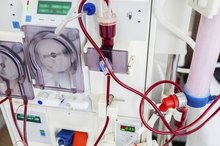What Is the Most Abundant Electrolyte Found in Blood Plasma?
Blood is composed of cellular material -- red blood cells, white blood cells and platelets -- as well as noncellular material. When the cells are removed from blood, a liquid substance called plasma remains. Plasma is water into which a wide variety of material is dissolved, including proteins, sugars and fats. These substances play diverse roles in the body, from protecting the body from infection to feeding cells.
Minerals and Electrolytes
Minerals are a vital component of blood plasma. These minerals exist primarily as salts which are dissolved in the plasma, and in the fluid inside the cells. These minerals are known as electrolytes. These minerals are inorganic compounds, meaning that they do not contain carbon. When they are dissolved in water, they break into ions. Positively charged ions are called cations; these include sodium and potassium. Negatively charged ions are called anions; some examples of anions are chloride and bicarbonate. Because of their charges, electrolytes can carry an electrical current; some electrolytes play a role in generating electrical charges within cells, causing nerves to fire, for example.
- Minerals are a vital component of blood plasma.
- These minerals are inorganic compounds, meaning that they do not contain carbon.
Location
Causes of Low Sodium Levels in the Body
Learn More
Electrolytes are found in both the extracellular compartment of the body, the blood, as well as the intracellular compartment of the body, the fluid inside the cells. The types of electrolytes and their amounts differ in the extracellular and intracellular component of the body 1. Within a cell, the most abundant electrolyte is potassium; within the plasma, the most abundant electrolyte is sodium.
Sodium
Sodium is the most abundant electrolyte, and the most abundant cation, in blood plasma. Chloride, present in a slightly smaller amount, is the most abundant anion. The normal amount of sodium in human plasma is 136 to 145 millimoles per liter, according to the “Laboratory Test Handbook.” Levels above or below this range can be dangerous.
Function
Dehydration & Potassium Levels
Learn More
Sodium plays a large role in maintaining water balance in the blood and in the tissues 1. The body monitors sodium and the volume of blood; sensors in certain parts of the body, such as the blood vessels and kidney, tell the kidneys whether to increase or decrease the excretion of sodium and water.
Sodium also plays an important role in the functioning of nerve and muscle cells. Sodium and potassium traveling back and forth across the membranes of cells generate a charge, which can cause a muscle cell to contract or a nerve cell to transmit a signal.
- Sodium plays a large role in maintaining water balance in the blood and in the tissues 1.
- The body monitors sodium and the volume of blood; sensors in certain parts of the body, such as the blood vessels and kidney, tell the kidneys whether to increase or decrease the excretion of sodium and water.
Imbalance
Both too much sodium and too little sodium can be dangerous. Too much sodium in the blood is called hypernatremia; its cause is most often loss of large amounts of water from the body, or from not consuming enough water. Severe hypernatremia can lead to death. Too little sodium in the body is called hyponatremia; this can be caused by consuming too much water, or by not excreting enough water. Like hypernatremia, hyponatremia can be fatal if left untreated.
- Both too much sodium and too little sodium can be dangerous.
- Too little sodium in the body is called hyponatremia; this can be caused by consuming too much water, or by not excreting enough water.
Considerations
Keeping electrolytes, especially sodium, in proper balance within the body is essential 1. Both very high and very low amounts of electrolytes can be fatal 1. The body is able to maintain this balance by many different methods; additionally, consuming the proper amount of fluid and electrolytes, especially with heavy exercise or illness, can contribute to proper levels within the body, and normal functioning of organs.
Related Articles
References
- The University of Tennessee, Graduate School of Medicine: Fluids, Electrolytes and Acid--Base Balance
- Langston C. Managing Fluid and Electrolyte Disorders in Kidney Disease. Vet Clin North Am Small Anim Pract. 2017;47(2):471-490. doi:10.1016/j.cvsm.2016.09.011
- Hoorn EJ, Zietse R. Diagnosis and Treatment of Hyponatremia: Compilation of the Guidelines. J Am Soc Nephrol. 2017;28(5):1340-1349. doi:10.1681/ASN.2016101139
- Muhsin SA, Mount DB. Diagnosis and treatment of hypernatremia. Best Pract Res Clin Endocrinol Metab. 2016;30(2):189-203. doi:10.1016/j.beem.2016.02.014
- Halawa I, Andersson T, Tomson T. Hyponatremia and risk of seizures: a retrospective cross-sectional study. Epilepsia. 2011;52(2):410-3. doi:10.1111/j.1528-1167.2010.02939.x
Writer Bio
Janna Smith has written health and fitness articles since 2000. She has co-authored papers in medical journals, including "Archives of Pathology and Laboratory Medicine." Smith is a practicing physician and Ironman triathlete. She received her medical degree from the University of Miami, and is board certified in anatomic and clinical pathology.









